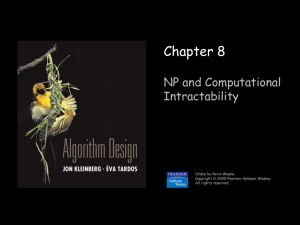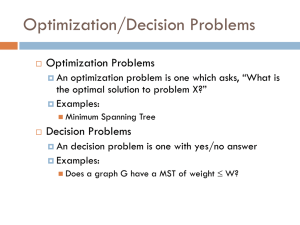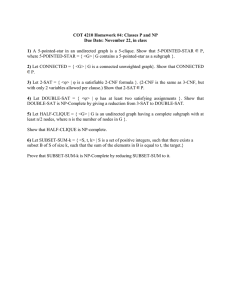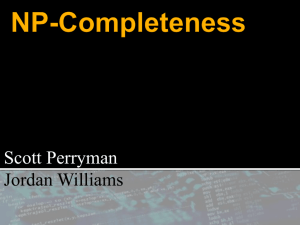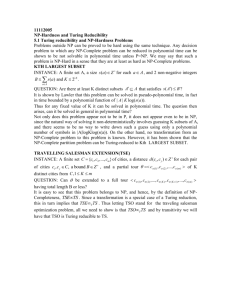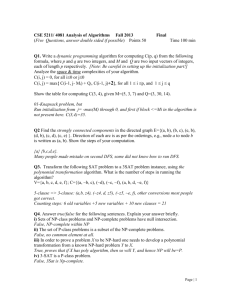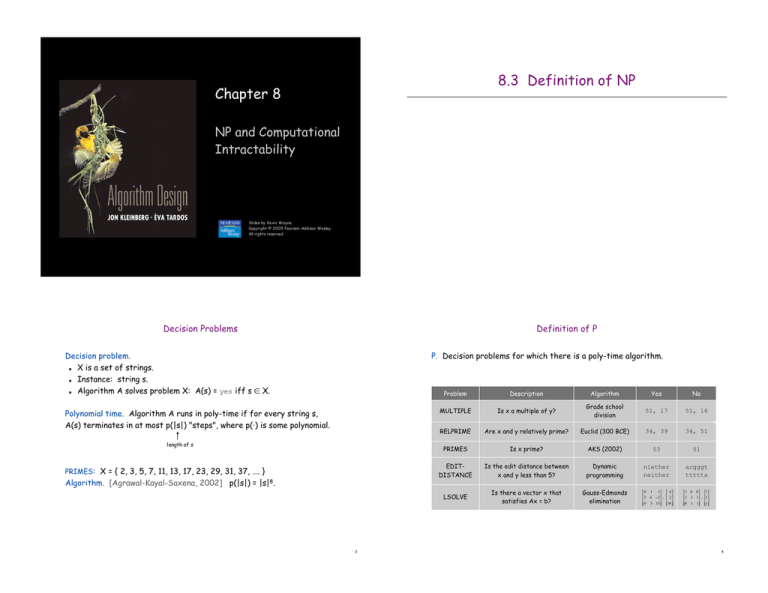
8.3 Definition of NP
Chapter 8
NP and Computational
Intractability
Slides by Kevin Wayne.
Copyright © 2005 Pearson-Addison Wesley.
All rights reserved.
1
Decision Problems
Definition of P
Decision problem.
X is a set of strings.
Instance: string s.
Algorithm A solves problem X: A(s) = yes iff s ! X.
P. Decision problems for which there is a poly-time algorithm.
!
!
Problem
!
Polynomial time. Algorithm A runs in poly-time if for every string s,
A(s) terminates in at most p(|s|) "steps", where p(") is some polynomial.
length of s
PRIMES: X = { 2, 3, 5, 7, 11, 13, 17, 23, 29, 31, 37, …. }
Algorithm. [Agrawal-Kayal-Saxena, 2002] p(|s|) =
|s|8.
Description
Algorithm
Yes
No
MULTIPLE
Is x a multiple of y?
Grade school
division
51, 17
51, 16
RELPRIME
Are x and y relatively prime?
Euclid (300 BCE)
34, 39
34, 51
PRIMES
Is x prime?
AKS (2002)
53
51
EDITDISTANCE
Is the edit distance between
x and y less than 5?
Dynamic
programming
niether
neither
acgggt
ttttta
LSOLVE
Is there a vector x that
satisfies Ax = b?
Gauss-Edmonds
elimination
# 0 1 1& # 4 &
%
( % (
% 2 4 "2 ( , % 2 (
%$ 0 3 15 (' %$36 ('
" 1 0 0 % "1%
$
' $ '
$ 1 1 1' , $1'
$#0 1 1'& $#1&'
!
3
!
4
NP
Certifiers and Certificates: Composite
Certification algorithm intuition.
Certifier views things from "managerial" viewpoint.
Certifier doesn't determine whether s ! X on its own;
rather, it checks a proposed proof t that s ! X.
COMPOSITES. Given an integer s, is s composite?
Def. Algorithm C(s, t) is a certifier for problem X if for every string s,
s ! X iff there exists a string t such that C(s, t) = yes.
Certifier.
!
Certificate. A nontrivial factor t of s. Note that such a certificate
exists iff s is composite. Moreover |t| # |s|.
!
boolean C(s, t) {
if (t # 1 or t % s)
return false
else if (s is a multiple of t)
return true
else
return false
}
"certificate" or "witness"
NP. Decision problems for which there exists a poly-time certifier.
C(s, t) is a poly-time algorithm and
|t| # p(|s|) for some polynomial p(").
Instance. s = 437,669.
Certificate. t = 541 or 809.
437,669 = 541 $ 809
Remark. NP stands for nondeterministic polynomial-time.
Conclusion. COMPOSITES is in NP.
5
Certifiers and Certificates: 3-Satisfiability
6
Certifiers and Certificates: Hamiltonian Cycle
SAT. Given a CNF formula &, is there a satisfying assignment?
HAM-CYCLE. Given an undirected graph G = (V, E), does there exist a
simple cycle C that visits every node?
Certificate. An assignment of truth values to the n boolean variables.
Certificate. A permutation of the n nodes.
Certifier. Check that each clause in & has at least one true literal.
Ex.
( x1
" x2 " x3 ) #
( x1
" x2 " x 3 ) #
( x1
Certifier. Check that the permutation contains each node in V exactly
once, and that there is an edge between each pair of adjacent nodes in
the permutation.
" x2 " x4 ) # ( x1 " x3 " x4 )
Conclusion. HAM-CYCLE is in NP.
instance s
!
x1 = 1, x2 = 1, x3 = 0, x4 = 1
certificate t
!
Conclusion. SAT is in NP.
instance s
7
certificate t
8
P, NP, EXP
The Main Question: P Versus NP
P. Decision problems for which there is a poly-time algorithm.
EXP. Decision problems for which there is an exponential-time algorithm.
NP. Decision problems for which there is a poly-time certifier.
Does P = NP? [Cook 1971, Edmonds, Levin, Yablonski, Gödel]
Is the decision problem as easy as the certification problem?
Clay $1 million prize.
!
!
Claim. P ' NP.
Pf. Consider any problem X in P.
By definition, there exists a poly-time algorithm A(s) that solves X.
Certificate: t = (, certifier C(s, t) = A(s). !
NP
EXP
EXP
P
!
P = NP
!
If P ) NP
Claim. NP ' EXP.
Pf. Consider any problem X in NP.
By definition, there exists a poly-time certifier C(s, t) for X.
To solve input s, run C(s, t) on all strings t with |t| # p(|s|).
Return yes, if C(s, t) returns yes for any of these. !
If P = NP
would break RSA cryptography
(and potentially collapse economy)
!
If yes: Efficient algorithms for 3-COLOR, TSP, FACTOR, SAT, …
If no: No efficient algorithms possible for 3-COLOR, TSP, SAT, …
!
!
Consensus opinion on P = NP? Probably no.
9
The Simpson's: P = NP?
10
Futurama: P = NP?
Copyright © 1990, Matt Groening
Copyright © 2000, Twentieth Century Fox
11
12
Looking for a Job?
8.4 NP-Completeness
Some writers for the Simpsons and Futurama.
J. Steward Burns. M.S. in mathematics, Berkeley, 1993.
David X. Cohen. M.S. in computer science, Berkeley, 1992.
Al Jean. B.S. in mathematics, Harvard, 1981.
Ken Keeler. Ph.D. in applied mathematics, Harvard, 1990.
Jeff Westbrook. Ph.D. in computer science, Princeton, 1989.
!
!
!
!
!
13
Polynomial Transformation
NP-Complete
Def. Problem X polynomial reduces (Cook) to problem Y if arbitrary
instances of problem X can be solved using:
Polynomial number of standard computational steps, plus
Polynomial number of calls to oracle that solves problem Y.
NP-complete. A problem Y in NP with the property that for every
problem X in NP, X # p Y.
!
Theorem. Suppose Y is an NP-complete problem. Then Y is solvable in
poly-time iff P = NP.
Pf. * If P = NP then Y can be solved in poly-time since Y is in NP.
Pf. + Suppose Y can be solved in poly-time.
Let X be any problem in NP. Since X # p Y, we can solve X in
poly-time. This implies NP ' P.
We already know P ' NP. Thus P = NP. !
!
Def. Problem X polynomial transforms (Karp) to problem Y if given any
input x to X, we can construct an input y such that x is a yes instance
of X iff y is a yes instance of Y.
!
we require |y| to be of size polynomial in |x|
!
Note. Polynomial transformation is polynomial reduction with just one
call to oracle for Y, exactly at the end of the algorithm for X. Almost
all previous reductions were of this form.
Fundamental question. Do there exist "natural" NP-complete problems?
Open question. Are these two concepts the same?
we abuse notation # p and blur distinction
15
16
Circuit Satisfiability
The "First" NP-Complete Problem
CIRCUIT-SAT. Given a combinational circuit built out of AND, OR, and NOT
Theorem. CIRCUIT-SAT is NP-complete. [Cook 1971, Levin 1973]
Pf. (sketch)
Any algorithm that takes a fixed number of bits n as input and
produces a yes/no answer can be represented by such a circuit.
Moreover, if algorithm takes poly-time, then circuit is of poly-size.
gates, is there a way to set the circuit inputs so that the output is 1?
!
output
,
sketchy part of proof; fixing the number of bits is important,
and reflects basic distinction between algorithms and circuits
¬
yes: 1 0 1
,
,
!
-
1
-
0
?
!
?
?
inputs
hard-coded inputs
!
Consider some problem X in NP. It has a poly-time certifier C(s, t).
To determine whether s is in X, need to know if there exists a
certificate t of length p(|s|) such that C(s, t) = yes.
View C(s, t) as an algorithm on |s| + p(|s|) bits (input s, certificate t)
and convert it into a poly-size circuit K.
– first |s| bits are hard-coded with s
– remaining p(|s|) bits represent bits of t
Circuit K is satisfiable iff C(s, t) = yes.
17
18
Example
Establishing NP-Completeness
Ex. Construction below creates a circuit K whose inputs can be set so
that K outputs true iff graph G has an independent set of size 2.
,
independent set?
independent set of size 2?
!
-
!
-
,
,
w
set of size 2?
Justification. If X is an NP-complete problem, and Y is a problem in
NP with the property that X # P Y then Y is NP-complete.
-
u
v
Recipe to establish NP-completeness of problem Y.
Step 1. Show that Y is in NP.
Step 2. Choose an NP-complete problem X.
Step 3. Prove that X # p Y.
¬
!
both endpoints of some edge have been chosen?
,
Remark. Once we establish first "natural" NP-complete problem,
others fall like dominoes.
,
,
,
Pf. Let W be any problem in NP. Then W # P X # P Y.
By transitivity, W # P Y.
by definition of
by assumption
Hence Y is NP-complete. !
NP-complete
!
!
G = (V, E), n = 3
u-v
u-w
v-w
u
v
w
1
0
1
?
?
?
"n%
$ '
#2&
!
hard-coded inputs (graph description)
n inputs (nodes in independent set)
19
20
3-SAT is NP-Complete
NP-Completeness
Theorem. 3-SAT is NP-complete.
Pf. Suffices to show that CIRCUIT-SAT # P 3-SAT since 3-SAT is in NP.
Let K be any circuit.
Create a 3-SAT variable xi for each circuit element i.
Make circuit compute correct values at each node:
– x2 = ¬ x3
+ add 2 clauses: x2 " x3 , x2 " x3
x1 " x4 , x1 " x5 , x1 " x4 " x5
– x1 = x4 - x5 + add 3 clauses:
– x0 = x1 , x2 + add 3 clauses:
x0 " x1 , x0 " x2 , x0 " x1 " x2
Observation. All problems below are NP-complete and polynomial
reduce to one another!
!
!
CIRCUIT-SAT
!
3-SAT
s to T
E
uce
red E NT S
AT
D
3 -S E PE N
D
IN
!
!
!
! output value.
Hard-coded input values and
x5
– x5 = 0 + add 1 clause: !
x0
– x0 = 1 + add 1 clause:
! of length < 3 into
Final step: turn clauses
!
clauses of length exactly
3. !
by defi ni ti on of NP-completeness
output
x0
INDEPENDENT SET
DIR-HAM-CYCLE
GRAPH 3-COLOR
SUBSET-SUM
VERTEX COVER
HAM-CYCLE
PLANAR 3-COLOR
SCHEDULING
SET COVER
TSP
,
x5
0
x1
x2
-
¬
?
x4
?
x3
21
22
Some NP-Complete Problems
Extent and Impact of NP-Completeness
Six basic genres of NP-complete problems and paradigmatic examples.
Packing problems: SET-PACKING, INDEPENDENT SET.
Covering problems: SET-COVER, VERTEX-COVER.
Constraint satisfaction problems: SAT, 3-SAT.
Sequencing problems: HAMILTONIAN-CYCLE, TSP.
Partitioning problems: 3D-MATCHING 3-COLOR.
Numerical problems: SUBSET-SUM, KNAPSACK.
Extent of NP-completeness. [Papadimitriou 1995]
Prime intellectual export of CS to other disciplines.
6,000 citations per year (title, abstract, keywords).
– more than "compiler", "operating system", "database"
Broad applicability and classification power.
"Captures vast domains of computational, scientific, mathematical
endeavors, and seems to roughly delimit what mathematicians and
scientists had been aspiring to compute feasibly."
!
!
!
!
!
!
!
!
!
!
NP-completeness can guide scientific inquiry.
1926: Ising introduces simple model for phase transitions.
1944: Onsager solves 2D case in tour de force.
19xx: Feynman and other top minds seek 3D solution.
2000: Istrail proves 3D problem NP-complete.
Practice. Most NP problems are either known to be in P or NP-complete.
!
!
Notable exceptions. Factoring, graph isomorphism, Nash equilibrium.
!
!
23
24
More Hard Computational Problems
8.9 co-NP and the Asymmetry of NP
Aerospace engineering: optimal mesh partitioning for finite elements.
Biology: protein folding.
Chemical engineering: heat exchanger network synthesis.
Civil engineering: equilibrium of urban traffic flow.
Economics: computation of arbitrage in financial markets with friction.
Electrical engineering: VLSI layout.
Environmental engineering: optimal placement of contaminant sensors.
Financial engineering: find minimum risk portfolio of given return.
Game theory: find Nash equilibrium that maximizes social welfare.
Genomics: phylogeny reconstruction.
Mechanical engineering: structure of turbulence in sheared flows.
Medicine: reconstructing 3-D shape from biplane angiocardiogram.
Operations research: optimal resource allocation.
Physics: partition function of 3-D Ising model in statistical mechanics.
Politics: Shapley-Shubik voting power.
Pop culture: Minesweeper consistency.
Statistics: optimal experimental design.
25
Asymmetry of NP
NP and co-NP
Asymmetry of NP. We only need to have short proofs of yes instances.
NP. Decision problems for which there is a poly-time certifier.
Ex. SAT, HAM-CYCLE, COMPOSITES.
Ex 1. SAT vs. TAUTOLOGY.
Can prove a CNF formula is satisfiable by giving such an assignment.
How could we prove that a formula is not satisfiable?
Def. Given a decision problem X, its complement X is the same
problem with the yes and no answers reverse.
!
!
Ex 2. HAM-CYCLE vs. NO-HAM-CYCLE.
Can prove a graph is Hamiltonian by giving such a Hamiltonian cycle.
How could we prove that a graph is not Hamiltonian?
Ex. X = { 0, 1, 4, 6, 8, 9, 10, 12, 14, 15, … }
Ex. X = { 2, 3, 5, 7, 11, 13, 17, 23, 29, … }
!
!
co-NP. Complements of decision problems in NP.
Ex. TAUTOLOGY, NO-HAM-CYCLE, PRIMES.
Remark. SAT is NP-complete and SAT . P TAUTOLOGY, but how do we
classify TAUTOLOGY?
not even known to be in NP
27
28
NP = co-NP ?
Good Characterizations
Good characterization. [Edmonds 1965] NP I co-NP.
Fundamental question. Does NP = co-NP?
Do yes instances have succinct certificates iff no instances do?
Consensus opinion: no.
!
!
!
Theorem. If NP ) co-NP, then P ) NP.
Pf idea.
P is closed under complementation.
If P = NP, then NP is closed under complementation.
In other words, NP = co-NP.
This is the contrapositive of the theorem.
!
If problem X is in both NP and co-NP, then:
– for yes instance, there is a succinct certificate
– for no instance, there is a succinct disqualifier
Provides conceptual leverage for reasoning about a problem.
!
Ex. Given a bipartite graph, is there a perfect matching.
If yes, can exhibit a perfect matching.
If no, can exhibit a set of nodes S such that |N(S)| < |S|.
!
!
!
!
!
29
30
Good Characterizations
PRIMES is in NP / co-NP
Observation. P ' NP I co-NP.
!
!
Theorem. PRIMES is in NP / co-NP.
Pf. We already know that PRIMES is in co-NP, so it suffices to prove
that PRIMES is in NP.
Proof of max-flow min-cut theorem led to stronger result that maxflow and min-cut are in P.
Sometimes finding a good characterization seems easier than
finding an efficient algorithm.
Pratt's Theorem. An odd integer s is prime iff there exists an integer
1 < t < s s.t.
t s"1
# 1 (mod s)
Fundamental open question. Does P = NP I co-NP?
!
!
t (s"1) / p $ 1 (mod s)
for all prime divisors p of s-1
Mixed opinions.
Many examples where problem found to have a non-trivial good
characterization, but only years later discovered to be in P.
– linear programming [Khachiyan, 1979]
– primality testing
[Agrawal-Kayal-Saxena, 2002]
Input. s = 437,677
!
Certificate. t = 17, 22 $ 3 $ 36,473
Certifier.
- Check s-1 = 2 $ 2 $ 3 $ 36,473.
- Check 17s-1 = 1 (mod s).
Fact. Factoring is in NP I co-NP, but not known to be in P.
prime factorization of s-1
also need a recursive certificate
to assert that 3 and 36,473 are prime
if poly-time algorithm for factoring,
can break RSA cryptosystem
- Check 17(s-1)/2 . 437,676 (mod s).
- Check 17(s-1)/3 . 329,415 (mod s).
- Check 17(s-1)/36,473 . 305,452 (mod s).
use repeated squaring
31
32
FACTOR is in NP / co-NP
Primality Testing and Factoring
FACTORIZE. Given an integer x, find its prime factorization.
We established: PRIMES # P COMPOSITES # P FACTOR.
FACTOR. Given two integers x and y, does x have a nontrivial factor
Natural question: Does FACTOR # P PRIMES ?
Consensus opinion. No.
less than y?
Theorem. FACTOR . P FACTORIZE.
State-of-the-art.
proved in 2001
PRIMES is in P.
FACTOR not believed to be in P.
Theorem. FACTOR is in NP / co-NP.
Pf.
Certificate: a factor p of x that is less than y.
Disqualifier: the prime factorization of x (where each prime factor
is less than y), along with a certificate that each factor is prime.
!
!
!
RSA cryptosystem.
Based on dichotomy between complexity of two problems.
To use RSA, must generate large primes efficiently.
To break RSA, suffixes to find efficient factoring algorithm.
!
!
!
!
33
34
Princeton CS Building, West Wall
Extra Slides
36
Princeton CS Building, West Wall
Not How To Give a PowerPoint Talk
(commercial break)
Character
ASCII
Bits
P
80
1010000
=
61
0111101
N
78
1001110
P
80
1010000
?
63
0111111
37
A Note on Terminology
A Note on Terminology
Knuth. [SIGACT News 6, January 1974, p. 12 – 18]
Knuth's original suggestions.
!
Find an adjective x that sounds good in sentences like.
EUCLIDEAN-TSP is x.
It is x to decide whether a given graph has a Hamiltonian cycle.
It is unknown whether FACTOR is an x problem.
!
!
!
!
!
!
!
Hard.
!
Tough.
Herculean.
Formidable.
Arduous.
Some English word write-ins.
!
but Hercules known
for strength not time
!
!
!
!
!
Note: x does not necessarily imply that a problem is in NP, just that
every problem in NP polynomial reduces to x.
!
!
!
!
!
!
39
Impractical.
Bad.
Heavy.
Tricky.
Intricate.
Prodigious.
Difficult.
Intractable.
Costly.
Obdurate.
Obstinate.
Exorbitant.
Interminable.
40
A Note on Terminology
A Note on Terminology: Made-Up Words
Hard-boiled. [Ken Steiglitz] In honor of Cook.
Supersat. [Al Meyer] Greater than or equal to satisfiability.
Hard-ass. [Al Meyer] Hard as satisfiability.
Polychronious. [Ed Reingold] Enduringly long; chronic.
like today's lecture
Sisyphean. [Bob Floyd] Problem of Sisyphus was time-consuming.
PET. [Shen Lin] Probably exponential time.
but Sisyphus never finished his task
depending on P=NP conjecture: provably exponential time,
or previously exponential time
Ulyssean. [Don Knuth] Ulysses was known for his persistence.
and finished!
GNP. [Al Meyer] Greater than or equal to NP in difficulty.
costing more than GNP to resolve
41
A Note on Terminology: Consensus
NP-complete. A problem in NP such that every problem in NP polynomial
reduces to it.
NP-hard. [Bell Labs, Steve Cook, Ron Rivest, Sartaj Sahni]
A decision problem such that every problem in NP reduces to it.
not necessarily in NP
NP-hard search problem. A problem such that every problem
in NP reduces to it.
not necessarily a yes/no problem
"creative research workers are as full of ideas
for new terminology as they are empty of
enthusiasm for adopting it." -Don Knuth
43
42

